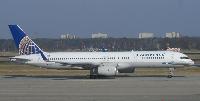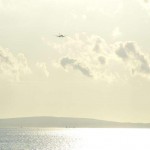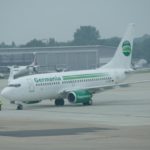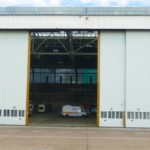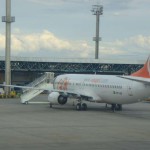Record fuel prices hurt results for quarter
Houston – Continental Airlines reported a second quarter 2008 net loss of $3 million ($0.03 diluted loss per share). Excluding $22 million of previously announced net after tax special items, Continental recorded a net loss of $25 million ($0.25 diluted loss per share).
The combination of record high fuel prices, weakening economic conditions and a weak dollar has resulted in the worst financial environment for U.S. network carriers since the 9/11 terrorist attacks.
„My co-workers are doing a great job working through the significant challenges facing our industry,“ said Larry Kellner, Continental’s chairman and chief executive officer. „We will continue to work together to react to the market and maintain our focus on providing quality service to customers.“
In response to these challenges, Continental implemented a number of initiatives in the second quarter of 2008 to maintain its competitive position in the industry and bolster its cash balance including:
– Announcing capacity reductions beginning in September 2008, which Continental expects will result in a 10-percent decline in domestic mainline capacity, a 15.4-percent decline in domestic mainline departures and a 6.7-percent decline in consolidated capacity in the fourth quarter 2008 compared to the same period 2007
– Accelerating the retirement of 67 Boeing 737-300 and 737-500 aircraft, removing a majority of the least fuel efficient aircraft from its mainline fleet by the end of 2009, driving the difficult decision to eliminate approximately 3,000 positions across all work groups
– Entering into a new seven-year capacity purchase agreement with ExpressJet Airlines, Inc. to provide regional jet service at lower rates, resulting in approximately $50 million of annual savings
– Raising approximately $900 million through a variety of initiatives including an amended credit card marketing agreement, issuance of common stock, sale of Continental’s remaining equity interest in Copa Holdings, S.A. (Copa) and several secured borrowings
– Entering into framework agreements for a planned transition to the Star Alliance, linking worldwide networks and services of alliance members including United, Lufthansa, Air Canada, Singapore, ANA and Air China, to benefit customers and create revenue opportunities, cost savings and other efficiencies
– Implementing a new checked bag policy charging non-Elite customers on certain economy-class tickets a $25 service fee for a second checked bag, and numerous fuel surcharge and fare increases
Second Quarter Revenue and Capacity
Total revenue for the quarter of $4.0 billion increased 9.0 percent ($334 million) over the same period in 2007, as a result of increased fuel surcharges on passenger tickets and on cargo, as well as international growth, increased fees and fare increases. Passenger revenue grew 7.5 percent ($254 million) compared to the second quarter of last year.
„Despite solid operational and financial performance, we were unable to generate enough revenue to keep pace with the stratospheric increase in fuel prices,“ said Jeff Smisek, president. „We will continue to take actions to increase our revenue and decrease our costs, while preserving our culture and core product integrity.“
Consolidated revenue passenger miles (RPMs) for the quarter increased 0.5 percent year-over-year on a capacity increase of 2.7 percent, resulting in a second quarter consolidated load factor of 81.4 percent, 1.8 points below the second quarter record set in 2007.
Consolidated yield for the quarter increased 7.0 percent year-over-year. Consolidated revenue per available seat mile (RASM) for the quarter increased 4.6 percent year-over-year due to increased yields.
Mainline RPMs in the second quarter of 2008 decreased 0.2 percent compared to the second quarter 2007, on a capacity increase of 2.0 percent. Mainline load factor was 81.7 percent, down 1.8 points year-over-year. Mainline yield increased 6.0 percent over the same period in 2007. As a result, second quarter 2008 mainline RASM was up 3.8 percent over the second quarter of 2007.
Second Quarter Operational Accomplishments
During the quarter, Continental recorded a U.S. Department of Transportation (DOT) on-time arrival rate of 73.1 percent and a systemwide mainline segment completion factor of 99.5 percent.
For the fifth straight year, Continental was named the „Best Airline in North America“ at the 2008 OAG Airline of the Year Awards.
In conjunction with the Transportation Security Administration (TSA), Continental expanded its paperless boarding pass pilot program, already in place at its Houston hub, to include its New York hub at Newark Liberty International Airport as well as Washington National Airport and Boston’s Logan International Airport. The program allows customers to receive boarding passes electronically on their cell phones or PDAs, which are scanned by TSA security officers at the checkpoint and can be used to board Continental’s flights, eliminating the need for paper boarding passes.
During the quarter, Continental launched the first-ever nonstop seasonal service between its hub at Cleveland Hopkins International Airport and Charles de Gaulle Airport in Paris, France.
High Fuel Costs Taking a Toll
Continental’s mainline cost per available seat mile (CASM) increased 15.1 percent (down 4.8 percent holding fuel rate constant and excluding special charges) in the second quarter compared to the same period last year. The company’s average price per mainline gallon of fuel, including fuel taxes, increased 66.2 percent year-over-year.
„We had another quarter of outstanding cost control excluding the impact of fuel,“ said Jeff Misner, Continental’s executive vice president and chief financial officer. „The entire team continues to impress me with their ability to find new ways to do things better and more efficiently, helping us mitigate rising fuel costs.“
Record-high jet fuel prices are adversely affecting the company’s financial results. In the second quarter of 2008, the price of a barrel of West Texas Intermediate crude oil averaged almost $119 per barrel compared to less than $65 per barrel for the same period last year, with crude oil prices peaking at $140.21 per barrel and Gulf Coast jet fuel peaking at $169.79 per barrel during the quarter. Mainline fuel costs increased 66 percent ($542 million) in the second quarter compared to the second quarter of 2007.
During the quarter, Continental also incurred additional fuel costs of $124 million year-over-year that were included as part of its regional capacity purchase cost. As a result, the total year-over-year impact of higher fuel costs on the company for the second quarter was $666 million, accounting for the company’s increase in operating expenses compared to the second quarter of 2007. Continental’s annualized fuel costs increase by approximately $43 million for each $1-per-barrel rise in the price of crude oil.
During the quarter, Continental recognized a total of $112 million in fuel hedging gains. Of this total, $79 million of realized gains were included as operating expenses when the underlying fuel hedged was used. The remaining $33 million are unrealized gains which relate to fuel hedges for the third quarter of 2008 and beyond which under accounting rules were required to be recognized in the second quarter. This $33 million of gains, which are included in the company’s statement of operations under nonoperating income (expense), were caused by the company’s hedge positions in crude and heating oil experiencing a relatively higher increase in value than the jet fuel being hedged.
As of July 16, 2008, Continental had hedged approximately 63 percent of the company’s projected consolidated fuel requirements for the third and fourth quarters of 2008, and had hedged approximately 29 percent of its projected consolidated fuel requirements for the first half of 2009.
Other Financial Accomplishments
During the quarter, Continental completed a public offering of 11 million shares of its common stock, raising net proceeds of $162 million, and sold its remaining equity stake in Copa, raising net proceeds of $149 million.
In June 2008, Continental amended its bankcard joint marketing agreement with Chase bank, under which Chase purchases frequent flyer mileage credits to be earned by OnePass members for making purchases using a Continental Airlines credit card issued by Chase. Under the agreement, Continental received a payment of $413 million, of which $235 million related to the advance purchase of frequent flyer mileage credits and the balance of which is in consideration of certain other commitments with respect to the co-branding relationship, including the extension of the term of the agreement until December 31, 2016.
During the second quarter, Continental closed transactions to borrow approximately $208 million under various debt agreements, secured by aircraft purchase agreements and mainline jet aircraft. The company received net proceeds of $173 million and expects to receive the remaining borrowings in the fourth quarter of 2008.
Continental ended the second quarter with approximately $3.4 billion in unrestricted cash and short-term investments, excluding all student loan related auction rate securities.
Fleet Changes Improve Efficiency
The company continues to improve fuel efficiency by adding modern, fuel efficient aircraft to its fleet and installing winglets on additional aircraft. During the quarter, the company took delivery of six new Boeing 737-900ER aircraft, which have one of the lowest operating costs in the fleet and allow Continental to serve high demand markets more efficiently. The company also took delivery of four new Boeing 737-800 aircraft in the quarter.
Continental’s young, fuel efficient fleet provides a natural hedge against rising jet fuel costs. The carrier is about 35 percent more fuel efficient per mainline revenue passenger mile than it was in 1997.
During the quarter, Continental installed winglets on two of the company’s 737-500s and seven 737-900 aircraft, and now has winglets on 244 of its mainline aircraft. All of the company’s 737-700s, 800s, 900ERs and 757-200s have winglets, as do select airplanes from Continental’s 737-300, -500 and -900 series fleets. Winglets increase aerodynamic efficiency and decrease drag, reducing fuel consumption and emissions by up to five percent.
In addition, Continental announced it will accelerate the retirement of 67 Boeing 737-300 and 737-500 aircraft from its fleet by the end of 2009, with 27 of these aircraft to be removed from service in September 2008.
Other Matters
Continental contributed $24 million to its defined benefit pension plans during the second quarter of 2008. On July 16, 2008, Continental contributed an additional $18 million for a total of $102 million in contributions to its defined benefit pension plans this year, satisfying the company’s required minimum contributions for calendar year 2008. Given current market conditions, the company does not plan to make additional contributions this year.
Continental entered into a new seven-year capacity purchase agreement (CPA) with ExpressJet, effective July 1, 2008. Under the amended CPA, ExpressJet will provide regional jet service for Continental at rates that are lower than rates under its prior agreement and more competitive with those offered by other regional service providers. The amended CPA covers a minimum of 205 regional jets in the first year and adjusts to 190 regional jets thereafter, subject to lease expirations.
In June 2008, Continental entered into a framework agreement with United Airlines to link networks and cooperate extensively on frequent flier programs, lounges, facility utilization, information technology and procurement services worldwide to the benefit of customers. In addition, Continental will apply to join the already established antitrust immunized alliance among United, Lufthansa, Air Canada and certain other members of the Star Alliance, with the goal of entering into international joint ventures with United and other members of the Star Alliance.

